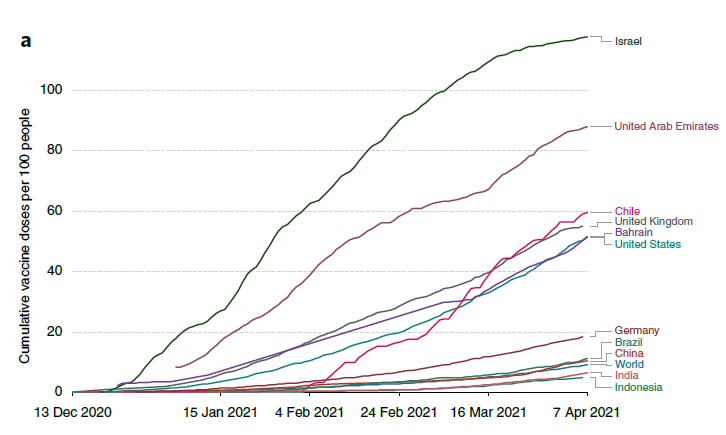Global COVID-19 vaccination: Large gap between Rich and Poor Countries
- Normal Liver Cells Found to Promote Cancer Metastasis to the Liver
- Nearly 80% Complete Remission: Breakthrough in ADC Anti-Tumor Treatment
- Vaccination Against Common Diseases May Prevent Dementia!
- New Alzheimer’s Disease (AD) Diagnosis and Staging Criteria
- Breakthrough in Alzheimer’s Disease: New Nasal Spray Halts Cognitive Decline by Targeting Toxic Protein
- Can the Tap Water at the Paris Olympics be Drunk Directly?
Global COVID-19 vaccination: Large gap between Rich and Poor Countries
Global COVID-19 vaccination: Large gap between Rich and Poor Countries. A summary analysis of the global vaccination situation shows that the gap between the rich and the poor is large, and the inequities are serious.
As of May 10, 2021, the cumulative number of COVID-19 infections worldwide has exceeded 158 million, and the cumulative death toll has exceeded 3.3 million.
Since the start of the COVID-19 pandemic, personal preventive measures such as social isolation, wearing masks, and frequent hand washing, as well as social measures such as extensive nucleic acid testing, school/factory closures, suspension of public gatherings, and travel restrictions, have helped reduce the spread of the COVID-19 virus. The mortality rate.
Now, with the successful development, marketing and mass production of a variety of vaccines, vaccination will become the ultimate weapon to contain the COVID-19 epidemic.
On May 10, 2021, researchers from the University of Oxford in the United Kingdom published a paper titled: A global database of COVID-19 vaccinations in the journal Nature Human Behaviour, a sub-Journal of Nature, which summarized and analyzed the current situation of COVID-19 vaccination around the world.
The research team has created a global public database of COVID-19 vaccination, which can track the scale and speed of global vaccination. The data set will be updated regularly, including the total number of vaccinations in all countries for which data is available, the first and second doses, daily vaccination rates and coverage rates.
The database helps policymakers and researchers understand the speed of current and potential vaccine launches, the potential impact of vaccination on pandemic outcomes (such as virus transmission, morbidity and mortality); and global inequalities in vaccine access.
Total number of vaccinations in each country and region
The United States and China have the largest total number of vaccinations against the COVID-19, followed by some countries in Europe, South America, and some countries in Southeast Asia. African countries generally have insufficient vaccinations.

The vaccination volume per 100 people and the country’s per capita GDP
Israel is a world leader. Bhutan, Chile, the Cayman Islands, and the United Arab Emirates have nearly 60 or more vaccinations per 100 people, but these countries are basically countries with small populations.

Cumulative vaccination amount per 100 people in the total population
The United States, Europe, China, and some countries in South America have higher vaccination rates.

The total number of inoculations per 100 people varies with time

Vaccination rate
Figure a shows the proportion of inoculation at least one dose, figure b shows the proportion of complete inoculation.

Vaccine development schedule
As can be seen from the table below, it often takes decades or even hundreds of years from the identification of the pathogen of an infectious disease to the development of a vaccine. For example, the measles vaccine takes 10 years, the cervical cancer vaccine takes 25 years, and the typhoid vaccine takes 105 years. In 1880, malaria has been discovered in 1880, and a vaccine has not yet been successfully developed for more than 140 years.
In sharp contrast, the COVID-19 vaccine only takes one year.

(source:internet, reference only)
Disclaimer of medicaltrend.org
Important Note: The information provided is for informational purposes only and should not be considered as medical advice.



